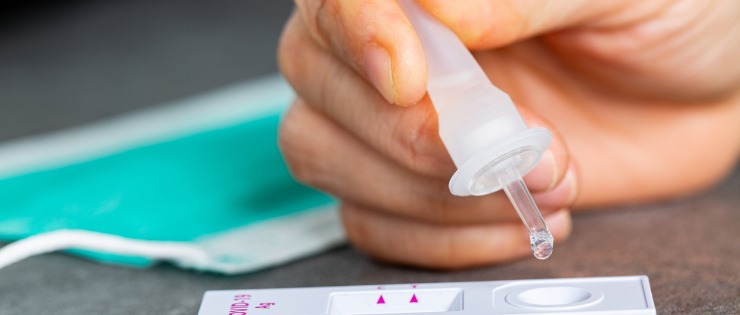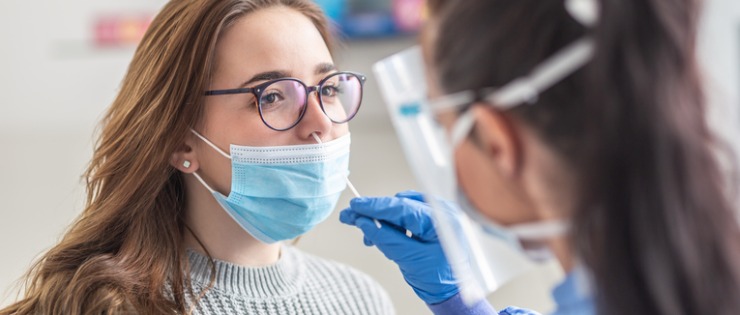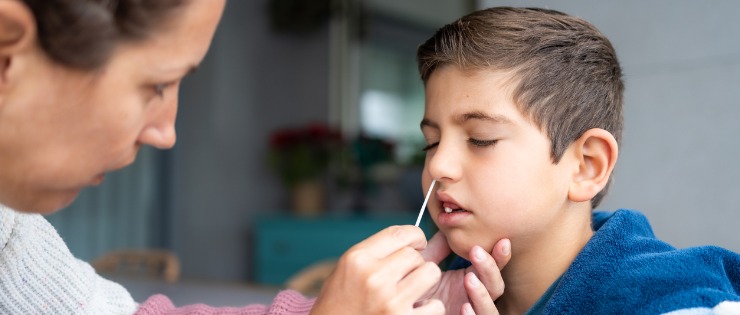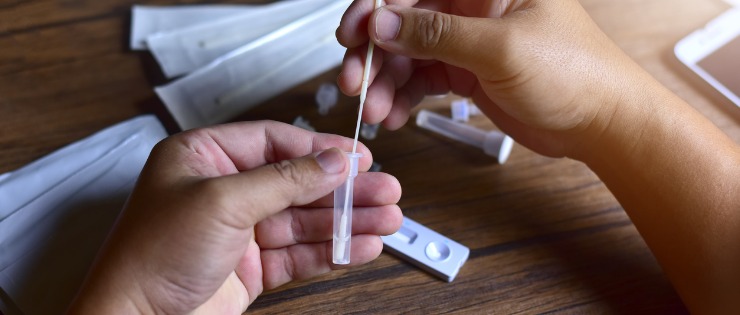
Rapid Antigen Tests (RATs) are now in most Australian homes, ready for when someone needs to test themselves for COVID-19. There’s no doubt they’re convenient - you don’t need to leave the house to join a queue for a test and a RAT gives you the results in less than 20 minutes, but are we putting too much faith in them?
Testing for COVID-19 Infection
There are two kinds of tests available to detect a COVID-19 infection - PCR and RAT.
Polymerase Chain Reaction (PCR)
A PCR test involves nasal and throat swabs, usually taken by a health professional at a testing clinic. The swabs are sent to a lab and depending on demand, the results are usually available within 24 hours. PCR tests were introduced early in the pandemic around the world. The results are considered very accurate when the swab is performed by a healthcare worker, however no test is 100% accurate.
In a 2020 laboratory study, a variety of PCR test kits correctly detected SARS-CoV-2 (the virus that causes COVID-19) more than 95% of the time (and frequently 100% of the time). There is a chance that a positive person will receive a negative PCR result if the sample was taken too early or late in the infection, the swab wasn’t taken correctly or contaminated during collection.
It’s very rare for a false positive test result to occur with a PCR (a positive test result for someone who doesn’t have the virus).

Rapid Antigen Test (RAT)
RATs have become popular since late 2021 when the Australian government recognised them as a viable alternative to PCR testing. This meant that people didn’t have to necessarily spend long periods of time queuing for a PCR test at a testing clinic.
Effectiveness of RATs
RATs sold in Australia have been approved by the Therapeutic Goods Administration (TGA). Approved RATs must have a sensitivity rating of 80%, which means when people with COVID-19 are tested, four out of five people (80%) will test positive. The specificity rating means when people who do not have COVID-19 are tested, at least 98% will get a negative result on the test. This equates to around one in every 50 people will get a false positive result for COVID-19.
RATs may not be accurate if the swab doesn’t collect enough nasal mucus or saliva for the virus to be detected. The first seven days of infection (including the day before symptoms) are the most accurate because the viral load is highest. Studies have shown that RATs work just as well in children as they do in adults, with similar sensitivity and specificity scores.
Taking a RAT too early is the main reason people receive a negative result but later test positive. If you think you may have been exposed to COVID-19, do another RAT in a day’s time or when symptoms appear.
It’s not required to have a PCR test to confirm a positive RAT, just make sure to follow the COVID-19 Test and Isolate National Protocols.

How To Do a RAT Nasal Swab Test
It’s important to read the instructions of every different RAT test you complete to ensure you do the test correctly according to the manufacturer’s instructions.
Wash your hands thoroughly with soap.
Open the RAT Kit and read the instructions.
Carefully place the liquid inside the tube .
Take hold of the swab without touching the soft tip and place the tip all the way into your nose until you feel it touch the back of your nose.
Keep moving the stick around your nose while you count to 15 slowly and press against the sides of the nose.
Take it out of your nose and do the same on the other side of your nose using the same soft tip. Repeat moving the stick around while counting slowly to 15.
Take the stick out and place it into the tube of liquid and stir the stick in the tube 10 times.
Gently squeeze the sides of the tube together 10 times.
Take the stick out of the tube and put the cap on tightly.
Get the strip that shows the result and squeeze three or four drops of the liquid (check your instructions) onto the circle strip.
Set your timer for the time outlined on the instructions (usually between 10 and 20 minutes).
When the time is up, read the strip without delay.
You should see a line against the letter C to confirm your test is valid. If there is no line against the letter T, your test is negative.
If you see a line against the T (even if it’s very faint), you have COVID-19.
If there is no line or only a line against the T, the test is invalid and you will need to do another test.
After reading the test result, throw the test kit in the bin and wash your hands and the surface you did the test on.
If your test was negative and you have symptoms, complete another test in one day’s time.
How to do a rapid antigen test (RAT)
How to Do a Saliva RAT (Lollipop Test)
Pharmacies also sell RATs that swab the mouth rather than the nose.
Wash your hands thoroughly with soap.
Remove the test from its packaging.
Place the sponge end in your mouth and swab the inside of your cheeks for 90 seconds.
Remove the swab from your mouth and check if the indicator on the back of the swab has turned blue.
Insert the swab into the test cassette hole and push it down until it clicks into place.
Read the test result after 10 minutes (check instructions for time).
You should see a line against the letter C to confirm your test is valid. If there is no line against the letter T, your test is negative.
If you see a line against the T (even if it’s very faint), you have COVID-19.
If there is no line or only a line against the T, the test is invalid and you will need to do another test.

What to Do if Your RAT Result is Positive
If the PCR test shows a positive result, you must isolate yourself at home. You’re also required to report a positive test to your local health authorities using the links below:
Your close contacts are also required to isolate at home for seven days. A close contact is someone who:
Lives in the same house as you.
Spent four hours or more with you without a mask.
Someone your state or territory health department deems to be a close contact.
If you are positive for COVID-19 or you’re a close contact, you can leave home and return to your usual daily living after seven days if you have no symptoms. Please add in State Government links for close contact rules and restrictions etc.
Medical Care
Most people experience mild COVID-19 symptoms that can be managed with over-the-counter medication such as ibuprofen or paracetamol. Some people may not experience any symptoms and are considered asymptomatic. However, you should seek urgent medical advice if your symptoms become severe such as difficulty breathing, an oxygen level of less than 92%, blue lips or face, pain or pressure in the chest, cold and clammy skin, faint or collapsing, confusion, difficult to wake, little urine output or coughing up blood.

RATs in Other Countries
Many countries recognised the benefit of RATs before Australia. With higher rates of infection and a desire to drop restrictions, RATs were a cheap and fast way for people to test themselves on a regular basis before leaving the house. The UK stopped lockdowns despite high case numbers, and offered citizens the opportunity to do regular tests at home. In Singapore, the test kits are available free from vending machines and the US mailed free RATs to households. Some countries have moved to supervised RATs for clearance to fly rather than using the more expensive and time-consuming PCR testing.
Free Rapid Antigen Tests
From 24 January 2022, Australians who hold an eligible Commonwealth concession card (Commonwealth Seniors Health Card, Department of Veterans Affairs Gold, White or Orange card, Health Care card, Low Income Health Card or Pensioner Concession card) can access up to 10 RATs over a three month period (maximum five over a one month period) through participating community pharmacies.
Some state governments have provided free RATs to households. The WA Government announced five free tests per household in February and another 10 free in March 2022.
Discounted Rapid Antigen Tests
In a bid to make rapid antigen tests (RATs) more accessible for members across Australia, HIF has partnered with the Australian Medical Association (AMA) in WA - a national partnership that takes a member-first approach. As a result, HIF members can now purchase discounted rapid antigen tests online with a promo code at the checkout.